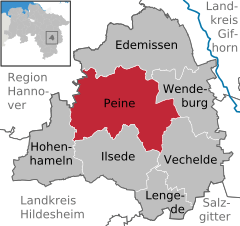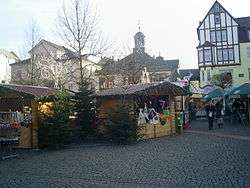Peine
| Peine | ||
|---|---|---|
|
Market square | ||
| ||
 Peine | ||
Location of Peine within Peine district 
 | ||
| Coordinates: 52°19′13″N 10°14′01″E / 52.32028°N 10.23361°ECoordinates: 52°19′13″N 10°14′01″E / 52.32028°N 10.23361°E | ||
| Country | Germany | |
| State | Lower Saxony | |
| District | Peine | |
| Government | ||
| • Mayor | Michael Kessler (SPD) | |
| Area | ||
| • Total | 119.51 km2 (46.14 sq mi) | |
| Population (2015-12-31)[1] | ||
| • Total | 49,366 | |
| • Density | 410/km2 (1,100/sq mi) | |
| Time zone | CET/CEST (UTC+1/+2) | |
| Postal codes | 31224–31228 | |
| Dialling codes | 05171 | |
| Vehicle registration | PE | |
| Website | www.peine.de | |
Peine (Eastphalian: Paane) is a town in Lower Saxony, Germany, capital of the district Peine. It is situated on the river Fuhse and the Mittellandkanal, approx. 25 km west of Braunschweig, and 40 km east of Hanover.
History
A deed from 1130 mentions Berthold von Pagin, ministerialis of Lothair III, emperor of the Holy Roman Empire, who gave his name to the town in the form of Peine. The castle, Burg Peine, dates to this era or before.
The 1201, the Hildesheim Chronicle describes a feud between the bishop Hartbert von Hildesheim and the brothers Ekbert and Gunzelin von Wolfenbüttel. Earl Gunzelin von Wolfenbüttel was the commander-in-chief of the German army and seneschal in attendance of Otto IV, emperor of the Holy Roman Empire. Gunzelin prevailed and won control of Burg Peine and the surrounding area.
South of the castle, Gunzelin founded the town of Peine in 1218 or 1220. In 1223, the settlement gained town privileges. Gunzelin's coat of arms has been the town's symbol ever since.
In 1256, Peine was conquered by Duke Albrecht of Braunschweig-Lüneburg, and after Gunzelin's death in 1260, his sons lost the fief of Peine to the bishop of Hildesheim.
Otto I of Braunschweig-Lüneburg, bishop of Hildesheim, 1260–1279, gave Earl Wedekind von Poppenburg the castle, town and county of Peine as a fief. Otto later incorporated Peine as a market town.
Also in 1260, Peine earned the right to mint and issue coins and was, with a few interruptions, a mint for the Bishopric of Hildesheim until 1428. In 1954 and 1956, two of the largest German medieval treasures of silver (95 pieces of round bullion, weighing 7.5 kg, dating from the 14th century) were found under the streets Stederdorfer Straße and Horstweg.
Notable natives
- Friedrich von Bodenstedt (1819–1892), author
- Rudolf Otto, Protestant theologian and scholar of comparative religion (1869–1937)
- Friedrich “Fritz” Hartjenstein, SS-Obersturmbannführer, commandant in the concentration camps Auschwitz-Birkenau and Natzweiler-Struthof (1905–1954)
- Solomon Perel, Israeli author (born 1925)
- Hans-Hermann Hoppe (born 1949)
- Caren Miosga, German journalist and television presenter Tagesthemen (born 1969)
- Herma Auguste Wittstock (born 1977)
International relations
Twin towns – Sister cities
Peine is twinned with:
-
 Heywood, England
Heywood, England -
 Aschersleben, Germany (since 1990)
Aschersleben, Germany (since 1990) -
 Tripoli, Greece (since 2000)
Tripoli, Greece (since 2000) -
 Heinola, Finland
Heinola, Finland -
 Nanchang, China (since 2009)[2]
Nanchang, China (since 2009)[2]
Pictures of Peine
 Former City Hall from 1827 on the market square
Former City Hall from 1827 on the market square- The Burgpark
 Jakobi-Kirche
Jakobi-Kirche Töpfers Mühle
Töpfers Mühle Steel Factory
Steel Factory Water Tower in southern Peine
Water Tower in southern Peine- Railway station
See also
References
| Wikimedia Commons has media related to Peine. |
- ↑ Landesbetrieb für Statistik und Kommunikationstechnologie Niedersachsen, 102 Bevölkerung - Basis Zensus 2011, Stand 31. Dezember 2015 (Tabelle K1020014)
- ↑ "Nanchang City and Sister Cities Intercommunion". Nanchang Municipal Party Committee of the CPC and Nanchang Municipal Government. Nanchang Economic Information Center. Archived from the original on 2013-05-22. Retrieved 2013-11-05.

